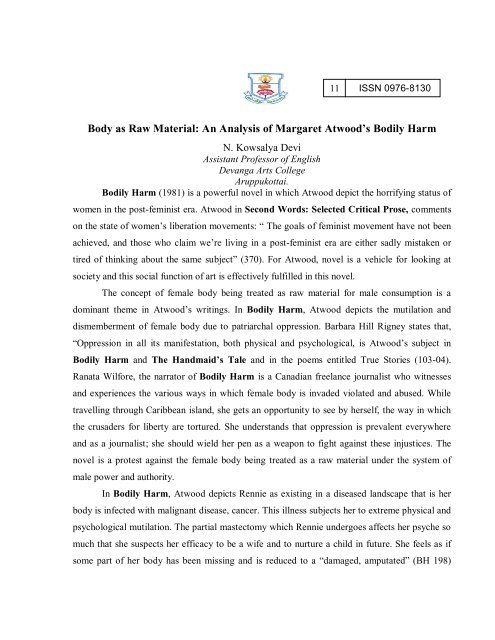A Multidisciplinary Research Journal - Devanga Arts College
A Multidisciplinary Research Journal - Devanga Arts College
A Multidisciplinary Research Journal - Devanga Arts College
You also want an ePaper? Increase the reach of your titles
YUMPU automatically turns print PDFs into web optimized ePapers that Google loves.
Body as Raw Material: An Analysis of Margaret Atwood’s Bodily Harm<br />
N. Kowsalya Devi<br />
Assistant Professor of English<br />
<strong>Devanga</strong> <strong>Arts</strong> <strong>College</strong><br />
Aruppukottai.<br />
Bodily Harm (1981) is a powerful novel in which Atwood depict the horrifying status of<br />
women in the post-feminist era. Atwood in Second Words: Selected Critical Prose, comments<br />
on the state of women’s liberation movements: “ The goals of feminist movement have not been<br />
achieved, and those who claim we’re living in a post-feminist era are either sadly mistaken or<br />
tired of thinking about the same subject” (370). For Atwood, novel is a vehicle for looking at<br />
society and this social function of art is effectively fulfilled in this novel.<br />
The concept of female body being treated as raw material for male consumption is a<br />
dominant theme in Atwood’s writings. In Bodily Harm, Atwood depicts the mutilation and<br />
dismemberment of female body due to patriarchal oppression. Barbara Hill Rigney states that,<br />
“Oppression in all its manifestation, both physical and psychological, is Atwood’s subject in<br />
Bodily Harm and The Handmaid’s Tale and in the poems entitled True Stories (103-04).<br />
Ranata Wilfore, the narrator of Bodily Harm is a Canadian freelance journalist who witnesses<br />
and experiences the various ways in which female body is invaded violated and abused. While<br />
travelling through Caribbean island, she gets an opportunity to see by herself, the way in which<br />
the crusaders for liberty are tortured. She understands that oppression is prevalent everywhere<br />
and as a journalist; she should wield her pen as a weapon to fight against these injustices. The<br />
novel is a protest against the female body being treated as a raw material under the system of<br />
male power and authority.<br />
11 ISSN 0976-8130<br />
In Bodily Harm, Atwood depicts Rennie as existing in a diseased landscape that is her<br />
body is infected with malignant disease, cancer. This illness subjects her to extreme physical and<br />
psychological mutilation. The partial mastectomy which Rennie undergoes affects her psyche so<br />
much that she suspects her efficacy to be a wife and to nurture a child in future. She feels as if<br />
some part of her body has been missing and is reduced to a “damaged, amputated” (BH 198)



